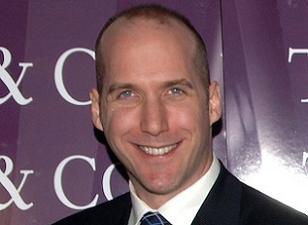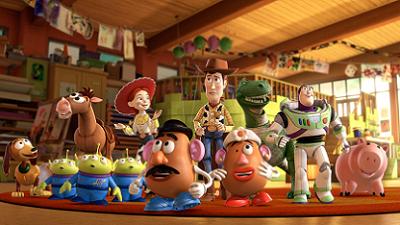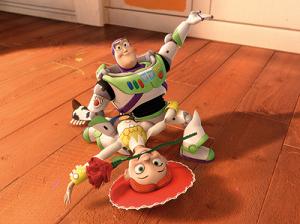![]()
Michael Arndt joined Pixar Animation Studios in 2005. In 2007, he won an Academy Award for Best Original Screenplay for his first film, Little Miss Sunshine. Toy Story 3, based on a story by John Lasseter, Andrew Stanton, and Lee Unkrich, is his first screenplay for Pixar.
At the invitation of Walt Disney Studios Home Entertainment, we had the opportunity to join a virtual roundtable with one of the people who crafted that incredible story that gave a totally unexpected depth to mere toys.
Please, meet the one who made all of us cry with bits of plastic and plush (but what bits of plastic and plush!)…Michael Arndt!

RI: Michael, can you talk about how you initially got set up with the Pixar people? Did you approach them or did they approach you?
MA: They approached me. Back in early 2005, Pixar was looking for a writer to work with Lee Unkrich on an original idea that he was planning to direct. One of the development people here at Pixar, Mary Coleman, bumped into Little Miss Sunshine producer Ron Yerxa at the Sundance Film Festival and asked him if he knew of any decent writers, and he recommended me. So I was hired at Pixar while LMS was still in the editing room. It’s a tribute to Pixar that they were willing to hire an untested writer (me) and subsequently trust him with one of their biggest movies.
RI: Were you surprised how Little Miss Sunshine took off?
MA: I was endlessly surprised — that I was able to sell it; that it got made; that it got picked up by a distributor; and that audiences embraced it. I always thought of it as a very small, very personal screenplay, so the fact that it went anywhere was surprising to me.

RI: Were you a fan of animation before working for Pixar? What are some of your favorite animated films?
MA: I’ve always loved animation. I took a few animation classes in film school [at NYU] and made a couple of animated short films, but I never dreamed I would get a chance to work in animation professionally. It’s hard to name a favorite, but the most important animated film to me is Isao Takahata’s My Neighbours the Yamadas. Seeing that film in 2000 is what prompted me to sit down and write Little Miss Sunshine after years and years of delay. So I have a special fondness for that movie (especially the Japanese-language version).
RI: What films have made the most impact on you, growing up and as an adult?
MA: One of my favorite films is Late Spring by Yasujiro Ozu. To me, it represents film as art.
RI: How much pressure did you feel trying to deliver a solid third film in the Toy Story franchise?
MA: It was basically more pressure than I’ve ever felt — or that I imagine I’ll ever feel — in my entire writing life. There were never any moments of panic or despair, but I really, really, really didn’t want to let anyone down, so the pressure was pretty agonizing for the entire four years of making the movie.

RI: Were you given any specific restrictions for the characters or the plot that you had to work within?
MA: This was — to me — the most amazing thing about my experience of working on Toy Story 3: we weren’t given any restrictions whatsoever. Obviously, we were working on a family film, so we were aiming for something that would appeal to everyone. But beyond those general expectations, we were never given any directives or restrictions of any kind, other than just “Make it great”. I remember sitting in the story room with Lee Unkrich, the director, and Jason Katz, the Head of Story, after we had spent six months on our own, hammering out the bare bones of the story, and I looked around and thought “Shouldn’t there be an adult in the room? Shouldn’t there be some Vice President, or producer, or toy manufacturer in here telling us what to do?” There was never any of that. We were encouraged to let our imaginations run wild, and (I hope) the film reflects that.
RI: The creative process for an animated film is quite different from a live-action one. Did that prevent you from having ongoing input into Toy Story 3‘s creation or were you kept in the loop throughout production?
MA: I was completely involved for the entire three years that it took to write the Toy Story 3 script. Once the script was finished, it took another year of production for the film to get finished. So I never felt shut out of the creative process of making the film — which is something that can often happen to writers on a live-action movie.
RI: Did you work on the final draft of the script and how much input did the other writers have on the final version?
MA: I worked on every draft of the script, of which there were dozens. But it was a deeply collaborative effort, with Lee Unkrich guiding the process every step of the way, John Lasseter and Andrew Stanton keeping us on course, and a whole team of story artists offering up jokes and ideas.
RI: Did you run any of the script by any younger person before writing the final version?
MA: We did do a test screening of the film when it was mostly complete — about 9 months before it was released — in front of a recruited audience of young children. I was afraid the film might be a little too dark for a family audience, but all the kids who saw it seemed to really like it, so we didn’t make any changes based on that screening. But it’s always smart to try to see the film through the eyes of people of all ages, just to make sure you’re not missing something.
RI: In hindsight of all the success the film has had, was there ever a time that you were afraid you weren’t writing to the “Pixar standard”.
MA: Pretty much the entire time I was writing the script (three years), I was afraid I wasn’t writing to the “Pixar standard”.

RI: How many drafts did you write until you ended up with the final script?
MA: At Pixar, the script actually gets broken down into 20 or 25 separate sequences. One of them, which we called “Map Hunt” (it’s when Woody is in Bonnie’s bedroom, trying to figure out how to get home), was written in only 6 or 7 drafts. Most sequences took 20 or 30 drafts. The opening staff meeting, which we called “Grown Up”, required 60 drafts.
RI: You’ve said in earlier interviews that even comedies should be about something, or have values and take a stand. What do you view as the values or position that you were taking when writing Toy Story 3?
MA: One of the biggest challenges of Toy Story 3 was figuring how the hero — Woody — would change over the course of the story. In the first Toy Story, Woody had to learn to share the spotlight with Buzz. In Toy Story 2, Woody faced and came to terms with his own mortality. For Toy Story 3, what we finally figured out was that Woody begins the story thinking that love means always being there for Andy. He’s similar to Lotso, in that he equates physical presence with the genuine expression of love, which is why he is so adamant in insisting that the Toys should “always be there” for Andy.
It’s only at the very end, when he witnesses Andy and his Mom saying goodbye, that Woody realizes you can love someone and still let them go, and that sometimes letting someone go can be the most loving thing a person can do. This is a universal experience — we all go through our lives getting to know people (childhood friends; high school sweethearts; college professors; work colleagues) that we can feel intensely connected to for part of our lives, but whom we have to let go of as we move through life. Recognizing this, and learning to accept it, is a fairly mature sentiment for Woody, and one that (to me, at least) nicely completes the arc of his character across all three movies.

RI: Do you have any specific writing rituals you do when you begin to write a screenplay?
MA: Yes — I like to begin every screenplay with a burst of delusional self-confidence. It tends to fade pretty quickly, but (for me, at least) there doesn’t seem to be any other way to start writing a script.
RI: You take your time to finish screenplays, which seems to work. How many screenplays do you work on at a time?
MA: I can write two scripts concurrently, but I usually prefer to do one at a time. However, I also usually have five or six story ideas that are percolating in my head at any one time, so it can get a little crowded in there.
RI: Some animated films often use pop culture references for quick laughs…Pixar seems to eschew that approach. In what other ways do films like Toy Story 3 strive for a timeless appeal?
MA: One of the things I really like about Pixar’s films — and which sets them apart from some other animated movies — is that Pixar has actors speaking (for the most part) in their own voices. No one’s putting on a “funny voice” just because the character is animated. Tom Hanks, for example, voices Woody in his own natural Tom Hanks voice. We try to make the stories and the characters feel as real as possible, and having the actors use their own voices is very much part of that. That helps (we hope) to give the movies a timeless appeal.

RI: Were you part in the decisions involving who would voice the characters?
MA: Like just about everything else at Pixar, casting is a collaborative process, so I was able to weigh in along with Darla Anderson, the producer, John Lasseter, and the rest of the Brain Trust. In the end, though, it tends to be the director — in this case Lee — who makes the final decision. But it was very nice, as a writer, to be included in the casting discussions.
RI: After studying the Disney/Pixar characters for this project, do you have a particular favorite character?
MA: I really like the character E, in The Incredibles just because I love hearing Brad Bird do her voice.
RI: I don’t think I’ve seen such a comprehensive DVD feature on the art of screenwriting. Was this fun for you, breaking down screenwriting as a whole and delving through these Pixar classics, including your Toy Story 3?
MA: Making the DVD feature was more fun than writing. When writing is going well, nothing is better or more fun. But when it’s not working, it can be pretty agonizing.
RI: Can you tell us what is on your plate next or is it top secret?
MA: It’s top secret. (Sorry.)

RI: Do you have any advice for writers just starting out, getting their feet wet?
MA: Just be patient. It took me ten years of writing before I finally sold my first script. I know that Malcolm Gladwell’s rule of 10,000 hours of practice is kind of a cliche at this point. But for me, that cliche is 100% true. It basically took me 10,00 hours of writing before I had any success at all.
RI: How much of your personal experience do you draw upon when writing a script?
MA: You have to draw on everything you have as a person. That’s less about specific moments and experiences, and more about remembering specific feelings — especially those feelings that can seem private and particular. But my experience is that the more you can be truthful about those memories or feelings, the more other people will respond to them. The best writing really does come from the deepest, most private part of you.
RI: Do you look forward to a career that balances Pixar and family efforts with more adult movies like Little Miss Sunshine?
MA: I look forward to having any career at all. Certainly, I would love to remain a part of the Pixar family for as long as they’ll have me. But I do also want to make a variety of different live-action films.
RI: Michael, as we close out this virtual roundtable, any final thoughts on Toy Story 3?
MA: I’m incredibly grateful to Pixar for letting me be a part of the Toy Story 3 process, and I very much hope that we were able to live up to the legacy of the first two films. Thanks to everyone out there for participating!
The Toy Story 3 four-disc combo is
Our thanks to Dre Birskovich.